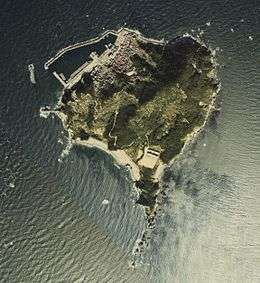Kami-shima
Kami-shima (神島) is an inhabited island located in Ise Bay off the east coast of central Honshu, Japan. It is administered as part of the city of Toba in Mie Prefecture.
| Native name: Kami-shima (神島) | |
|---|---|
 National Land Image Information (Color Aerial Photographs), Ministry of Land, Infrastructure, Transport and Tourism. | |
| Geography | |
| Location | Mie Prefecture |
| Coordinates | 34°32′N 136°59′E |
| Area | 0.76 km2 (0.29 sq mi) |
| Coastline | 3,900 m (12,800 ft) |
| Highest elevation | 171 m (561 ft) |
| Highest point | Tōmyōyama |
| Administration | |
Japan | |
| Demographics | |
| Population | 534 (2000) |
| Pop. density | 703/km2 (1,821/sq mi) |
| Ethnic groups | Japanese |
The name of Kami-shima has alternatively been written with as Kameshima (亀島) or Kajima (歌島); its present form of Kami-shima, or “God island” refers to the Shinto shrine. Yatsushiro Jinja, on the island. Archaeologists have found hundreds of ceremonial artifacts, ranging from ancient mirrors to ceramics dating from the Kofun period through the Muromachi period on the island. During the Edo period, the island was used as a prison by Toba Domain, with the sobriquet “Shima-Hachijo” is reference to the prison island of Hachijō-jima used by the Tokugawa shogunate.
The island is the setting for the 1954 novel by Yukio Mishima The Sound of Waves, and has been used several times as a filming location for movies.
The economy of the island is based on commercial fishing in its adjacent waters, and on tourism.
| Wikimedia Commons has media related to Kami Island (Mie). |
See also
References
- Saishin-Nihon-chizu - Atlas of Japan, Imidas Shueisha, Tokyo 1990